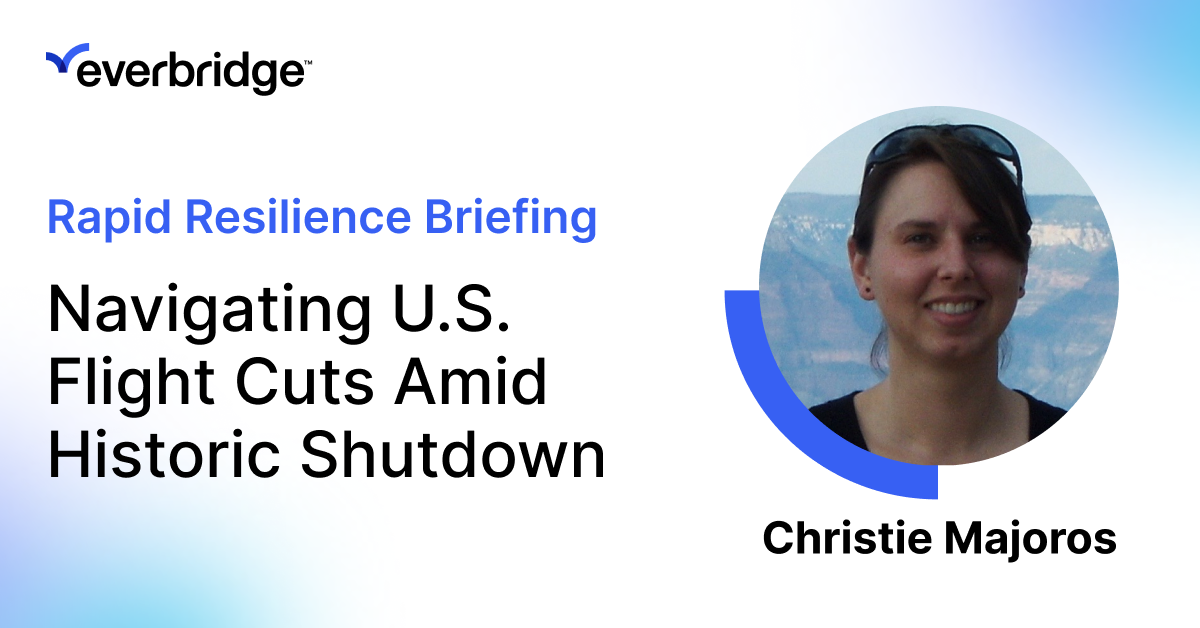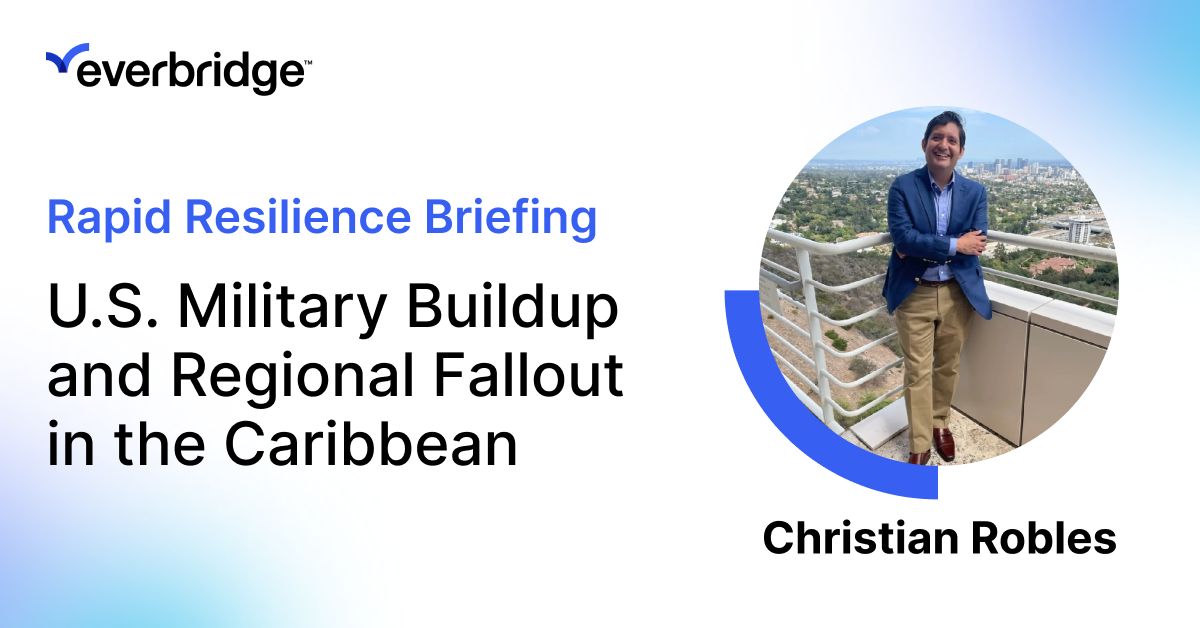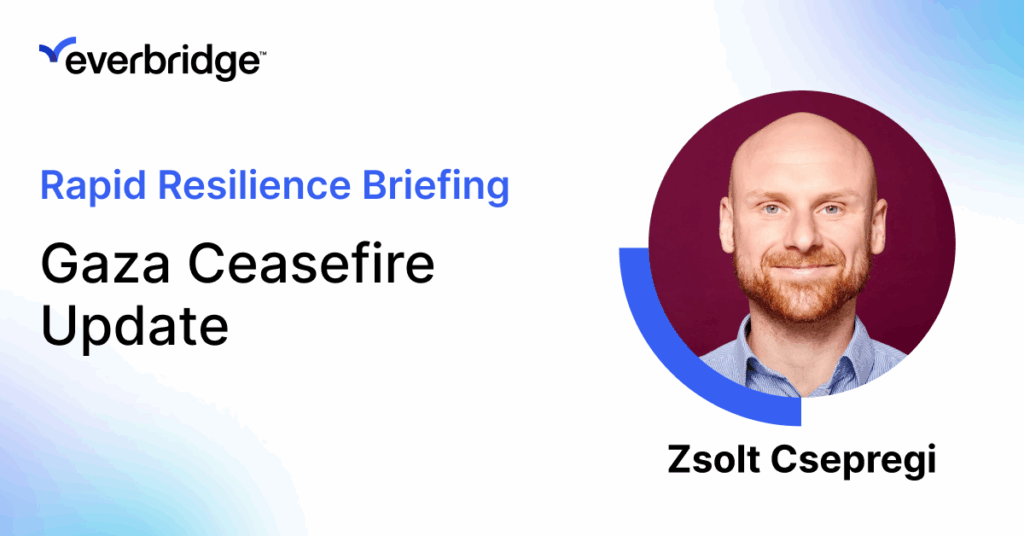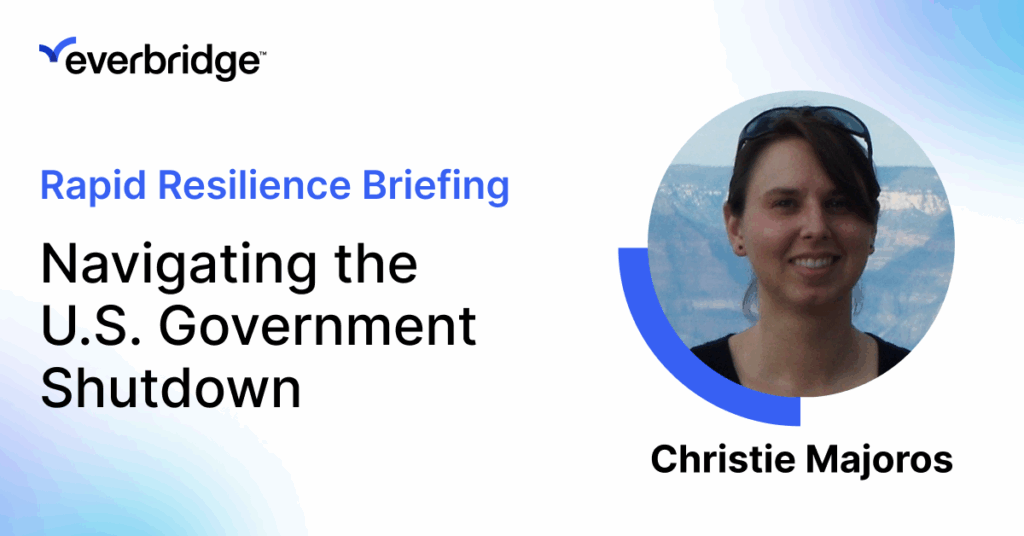
Top 10 questions to ask when Choosing the right business continuity platform
In today’s environment of heightened risk, operational complexity, and regulatory scrutiny, selecting the right business continuity platform is more than a technical decision—it’s a strategic imperative. Whether you’re a Business Continuity Manager ensuring plan effectiveness, a Risk Officer safeguarding compliance, or an IT Disaster Recovery (DR) leader striving for uninterrupted service delivery, your organization’s resilience depends on having the right tools in place.
Everbridge delivers a business resilience advantage with High Velocity CEM™, protecting organizations from the impact of critical events. By combining market-leading innovation, decision-ready risk intelligence, and full lifecycle automation, Everbridge ensures that managing critical events is as easy as 1-2-3. Only Everbridge helps organizations know earlier, respond faster, and improve continuously.
Selecting the right business continuity platform is a significant decision with long-term implications. It’s therefore essential to ask the right questions to ensure that the chosen solution aligns with your organization’s unique needs. To simplify your due diligence process, we’ve compiled the top 10 questions to ask potential business continuity vendors, along with valuable insights to guide your evaluation.
1. How does the platform centralize data and processes?
A strong platform should consolidate all business continuity, disaster recovery, and risk data into a single system. Centralization ensures consistency by using key data sources, reduces silos, improves visibility, and streamlines decision-making during disruptions.
What to ask:
- What type of templates are provided out of the box to get me started?
- Can the platform integrate data from existing tools like HR, facilities management, IT CMDB, risk management, and incident management solutions?
- Are there standardized import templates to manage my data?
- Does the platform provide an enterprise impact map with a unified view of dependencies and risks in my organization?
- Can I visually see upstream and downstream dependencies to understand single points of failure and critical assets?
- Can the data be segmented between business and IT DR?
- Does the platform provide standard summary reports and dashboards to see the health and status of my program and gaps to be addressed?
2. How configurable and adaptable is the platform?
The platform should be flexible enough to meet your organization’s unique needs while allowing for future growth and changes.
What to ask:
- Can I add new data tables and fields to match my organizational data?
- Are templates, calculations, and reports modifiable?
- How easily can I create new assessment templates, plan templates, and reports?
- Can I enhance a template and retain historical information and responses?
- Do I need technical expertise to apply changes to my templates, calculations, and reports? Does this require engagement with the vendor or a third party?
- Will I still receive upgrades and enhancements if I made configuration changes or modified templates?
3. Does the platform support regulatory compliance?
Compliance is a critical component of business continuity and disaster recovery. The platform should help you meet standards like ISO 22301, FFIEC, FCA, DORA, and SOC 2 while simplifying audit preparation.
What to ask:
- Does the platform provide audit logging of Business Continuity (BC)/DR activities?
- Will I receive updated templates and reports that align with regulatory requirements?
- Is there an automated workflow to alert users when information requires attention or updating?
- Can I easily generate compliance reports to provide to auditors and examiners?

4. What pre-built resources and templates does the platform offer?
Look for platforms that provide ready-to-use templates and workflows aligned with industry standards to save time and ensure consistency.
What to ask:
- Are the templates aligned with industry standards and best practices?
- Do they cover key areas like impact assessments, planning, testing, risk management, and reporting?
- Can templates be easily configured without technical expertise?
- Can I easily modify dropdown options to align with my terminology and resource types?
5. Dependencies
Understanding dependencies is key to effective recovery planning. The platform should visualize upstream and downstream dependencies and identify single points of failure.
What to ask:
- Can I configure the dependency view to see what matters to me?
- Are orphaned records and critical dependencies easily viewable?
- Does the platform provide tools to assess the impact of failures across the organization?
- Can I filter and see key asset dependencies at multiple levels?
- Are dependencies considered when testing my plans?
- Can I see where there are gaps in my response and recovery times for key dependencies such as applications and suppliers?
6. What type of reporting is available in the platform?
All tasks are not the same and should be dynamic based on the response phases and plan type they are associated with.
What to ask:
- Does the platform provide out-of-the-box reports for Business Impact Analysis, Plans, Risks, and Testing?
- Can I create new reports?
- Can reports be automatically sent to stakeholders without manual intervention?
- Are gaps for recovery time objectives (RTOs) easily identified (i.e. application recovery, supply chain, exercises)?
- Are summary reports available to roll data up to location, business entity, or executive leader/stakeholder?
- Can non-licensed users access copies of plans?
- Does the platform provide standard summary reports and dashboards to see the health and status of my program and gaps to be addressed?
7. What automation capabilities does the platform offer?
Automation reduces manual effort and ensures consistency. The platform should support automated workflows for creating, updating, and approving plans, as well as testing and tracking results.
What to ask:
- Can the platform automate alerts, testing, and reporting?
- Does it include automated workflows for cross-departmental collaboration?
- Can workflows be modified based on my organizational settings and frequency for updates?
- Can the platform escalate delinquent activities to leadership for higher levels of visibility and accountability?
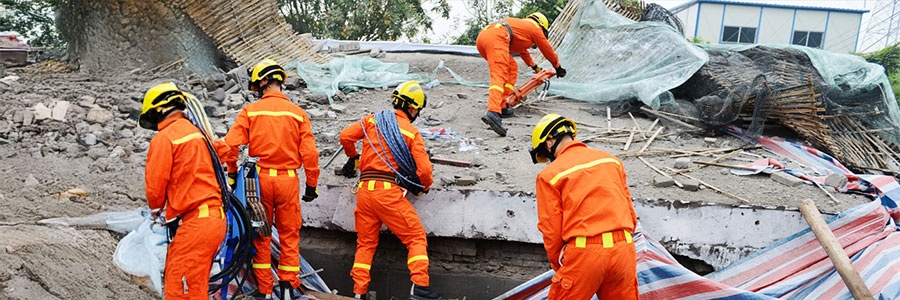
8. How does the platform support program visibility?
Dashboards and analytics are essential for tracking program health and readiness. The platform should provide real-time insights and executive-level reporting.
What to ask:
- Can it generate reports that communicate ROI and resilience metrics to stakeholders?
- Does it offer dashboards to visualize program health and readiness?
- Can I create or modify my own reports or do I need to engage with the vendor?
- Can I track the progress of recovery when conducting an exercise/test?
9. Does the planning platform provide integration with critical event management?
Integrating planning with critical event management is essential because it bridges the gap between proactive preparedness and real-time response. Together, they create a seamless, end-to-end approach for managing disruptions, ensuring the plan information is accessible, visible, and leveraged for response activities.
What to ask:
- Does the platform provide automated integration between planning and critical event management for free?
- What information is available from my BIA (Business Impact Analysis) and plan to help make informed decisions regarding impact?
- Can I see the dependencies and resources required for recovery?
- Can I activate plan response strategies and track recovery tasks being completed?
- Does my executive team understand why incidents were invoked and see incident trends over time?
- Does the platform show my team which services to restore and in what order during an incident?
10. What training and support are available?
Even the most intuitive platform requires training and support. The vendor should offer resources to ensure smooth onboarding and long-term success.
What to ask:
- What onboarding and training options are included?
- Is ongoing support available to address future needs and challenges?
- Is support a paid service or included in the subscription?
- Do I need to engage with a third-party vendor for support or changes to myprogram and what is the cost?
- Are there self-service training sessions available if I want to expand my use of theplatform?
- Do I need a license for test participants and infrequent users such as plan or BIAapprovers?
- How long is a typical implementation?
Making a well-informed decision
Choosing the right business continuity platform isn’t just about features; it’s about finding a reliable partner. By asking these 10 questions, you’ll be equipped to identify the best solution for your organization’s needs, ensuring resilience and operational continuity for years to come.

Full transcript
00:05
Hello, my name is Christian Robles and I’m the regional analyst for Latin America in the Caribbean here at Everbridge. We’ve been following this story since mid August when reports first surfaced that the US was deploying naval and air assets into the southern Caribbean.5sAdd a noteJump to
00:22
Early positioning framed as a counter narcotics buildup against so-called narot terrorists in the region. Two months later, that buildup has become a live operation. The US has now conducted 10 confirmed strikes. Eight in the Caribbean Sea and two in the Eastern
00:40
Pacific, killing at least 43 people and capturing two others. The latest strike hit a Drenad Aagua vessel in international waters. And hours later, Washington ordered the deployment of the Gerald R. Ford carrier strike group into the region under US southern command.
01:02
This marks a turning point. What began as targeted interdictions is now a full-scale power projection in the Western Hemisphere. And looking ahead, if this continues, several outcomes are possible. First, the operation could expand beyond the sea. President Trump has said he
01:22
won’t seek a declaration of war and that land operations will be next. That raises the prospect of covert actions inside Venezuela or air strikes on inland targets. Redrawing the map of US engagement in South America. Second, regional alignment is hardening. Colombia accuses Washington of
01:45
extrajudicial killings while Venezuela is mobilizing forces along its borders and warning of asymmetrical warfare. Meanwhile, Trinidad and Tobago is moving the other direction, hosting the destroyer USS Graveley and 2,000 Marines this week for joint exercises. The
02:05
island has become Washington’s southern anchor, a forward partner now facing greater exposure to Venezuelan cyber and intelligence pressures. And third, the commercial impact for shipping energy and insurance. The southern Caribbean is shifting from a patrol zone to a contested operating environment.
02:29
It’s expected temporary port closures in Trinidad and Tobago, higher war risk and detention premiums within 200 nautical miles of Venezuelan waters and strict sanctions screenings as the US expands terror designations. If exclusion zones appear or if Venezuela begins shadowing commercial
02:49
traffic, markets will react quickly. Since August, this campaign has evolved from deterrence to execution. The language deployments and now the carrier group all signal a sustained operational phase. If the tempo continues, the next step could move Finland. A shift that would
03:09
rattle regional stability and the confidence of US companies moving goods, fuel or data through these routes. We’ve been covering this from all angles and the takeaway is clear. We recommend monitoring unfolding events. Each new strike, asset movement signals that this
03:30
operation isn’t slowing, and the longer it runs, the harder it becomes to unwind. I’m Christian Robas, and we’ll continue tracking how these developments shape risk and stability across the region in the days ahead.
In our latest Rapid Resilience Briefing, we analyze the new phase-one Gaza ceasefire, a fragile starting point but not a complete peace plan.
Full transcript
[[00:05.0]
Hello, my name is Zsolt Csepregi. I’m the regional, analyst for the Middle east and North Africa at Eberbridge’s Global Insights Team. Today I will outline the ceasefire deal between Israel and Hamas and highlight the associated security and business risks. The newly announced Gaza ceasefire, which was brokered by the United States, Egypt, Turkey and Qatar, is a phase one agreement which is designed to secure the release of Israeli hostages in exchange for Palestinian prisoners, assured limited withdrawal of Israeli forces from Gaza and expanded humanitarian aid access.
[00:39.4]
It’s an important step, but it’s not a solution. Mediators themselves call it a starting point. A narrow humanitarian and political transaction, but not a complete peace plan. The goal right now is simple, to stop the immediate fighting and get the Israeli hostages home.
[00:55.9]
Everything beyond that, from Hamas disarmament to the future of Gaza’s governance, remains deeply contested. The second phase, meant to turn this truce into a sustainable political settlement, will be much harder. Israel insists that Hamas must be disarmed and excluded from the governance of Gaza.
[01:14.9]
While Hamas for its part, refuses to surrender control or its legitimacy. These positions are fundamentally incompatible once the immediate pressure eases. So the Israeli hostages are home and Israeli troops pull back, both sides will have far less incentive to compromise.
[01:34.7]
External actors are also shaping this trajectory. Palestinian Islamic Jihad has cautiously accepted the deal, but there is still a risk that more militant elements within Hamas or BIG could splinter towards Islamic State aligned, groups that outrightly reject any form of political compromise with Israel.
[01:55.6]
The Houthis in Yemen continue to reject the ceasefire outright, keeping Red Sea maritime risks elevated, while Hezbollah remains deliberately ambiguous along the northern border of Israel. For businesses and international operators, this environment represents de escalation without guaranteeing a resolution.
[02:15.4]
It’s a reduction in immediate violence, but not in underlying instability. So logistics and air travel are likely to remain volatile with potential disruptions from renewed rocket fire, drone attacks or political protests.
[02:30.5]
And beyond the region, pro Palestinian and pro Israeli demonstrations will continue across major global cities, carrying reputational and operational risk for multinational firms. Global companies should therefore remain vigilant and adaptable as this first phase of the ceasefire unfold and negotiations on the second phase start.
[02:51.0]
Even if progress continues, instability will persist across the Middle East. Organizations should diversify logistic routes, review travel and security protocols and maintain flexible staffing and crisis communication plans. Monitoring both of regional developments as well as protest movements globally will be key in protecting personnel and operations.
[03:12.8]
The coming months will demand strategic patience coupled with operational flexibility as the ceasefire talks may reduce violence temporarily but are far from assuring a lasting stability.
In our latest Rapid Resilience Briefing, Christie Majoros explains how the current U.S. government shutdown differs from previous ones with little compromise in sight.
Full transcript
[00:04.9]
Hello, my name is Christie Majoros. I am the Regional Analyst for North America on Everbridge’s Global Insights team. And today I’ll be giving a brief update on the current government shutdown, which is in its seventh day after starting on October 1st. At this time, there is little indication of the compromise in voting which would end the current shutdown and reopen the government.
[00:24.7]
And this is seeming unlikely to happen today or perhaps even this week. Government shutdowns are nothing new. We saw them during the previous Trump administration, and we saw them during the Obama administration. Like previous shutdowns, this current shutdown is causing many of the same problems in the halting of the disbursement of federal funding and also in the furloughing of the federal employees that run federal agencies.
[00:52.7]
However, unlike previous shutdowns, which were a temporary pause on government processes, this current shutdown has been seized upon as an opportunity for the administration to reallocate federal resources so that they are more in keeping with current executive priorities.
[01:14.5]
We’re seeing this happen in two ways. First, in the withdrawal or the cut to federal funding for certain projects. We’ve seen this, for major infrastructure projects in New York and Chicago, and also for clean energy projects in at least 16 other states to date.
[01:36.7]
Second, the President has announced that there are likely to be further personnel cuts to federal agencies. At this time, those agencies have not been named specifically. However, taking into account current executive priorities and the cuts made to federal agencies earlier this year, we might surmise that these are agencies that will be related to civilian, regulatory or science matters.
[02:04.2]
However, this remains to be seen. So what does this mean for businesses? Well, like any shutdown, this largely puts a pause on the government processes that interact with businesses. However, unlike a typical shutdown, whose effects would be temporary, this shutdown will have a reshaping effect on the federal government.
[02:28.9]
This means that many sources of federal funding or federal processes may not resume after the shutdown is resolved. And this will have a big impact on which industries will be able to grow and which will find this more difficult in the post shutdown period.
[02:48.9]
For right now, in addition to the practical problems created by this shutdown, there’s also this large uncertainty, in a situation which is very high stakes and increasingly volatile. So what can businesses do to mitigate?
[03:04.7]
Well, they can strengthen cash reserves, they can look beyond federal contracts, and they can stay alert to policy shifts, so that they can quickly adjust if funding or regulations change. In short, they can be prepared, they can keep an eye on the situation and be prepared for the possibility of a long term disruptive change.
